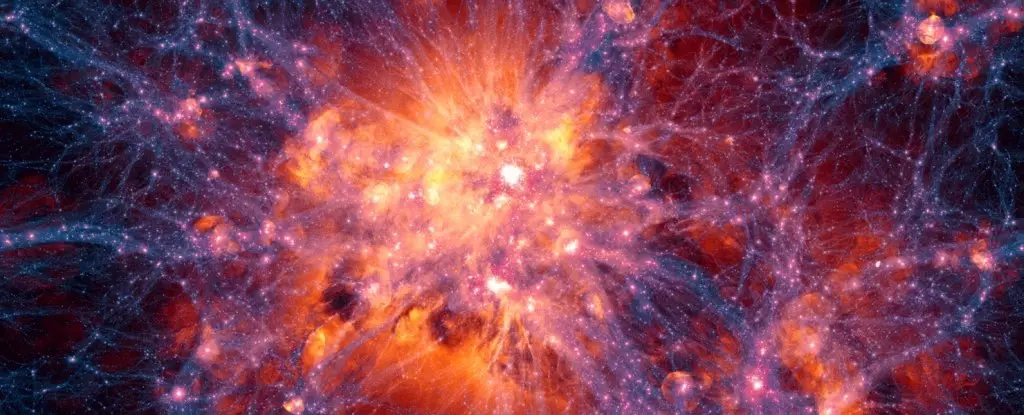General relativity, a cornerstone of modern physics formulated by Albert Einstein in the early 20th century, continues to provide profound insights into the workings of our Universe. Recent advancements in observational astronomy have put this historic theoretical framework to the test on an unprecedented scale. A comprehensive study involving a large collaboration of astronomers has meticulously mapped about 6 million galaxies, tracing their distribution over an astounding 11 billion years of cosmic history. This monumental effort not only evaluates the clumping of galaxies under the influence of gravity but also scrutinizes the very fabric of Einstein’s predictions across the vast scales of the Universe.
The study, emphasizing the evolutionary characteristics of galaxy clustering, reinforces the notion that gravitational interactions shape the cosmic landscape, despite the relentless expansion of the Universe itself. These new observations are indicative of a critical validation of general relativity, underscoring that the theory remains robust when contemplating both grand cosmic structures and minute celestial bodies.
Gravity is one of the fundamental forces governing the cosmos, yet its nuances challenge our understanding. At its core, gravity is responsible for the attractive force between masses, dictating the motions of planets, stars, and galaxies. It also warps space-time, bending the very fabric of our Universe. Dark matter plays a crucial role here, acting as an unseen framework that supports and stabilizes the structures we observe. As astronomers delve deeper into the intricate cosmic web, they reveal how most matter in the Universe comprises strings and filaments shaped by gravitational influences.
The intricate architecture of this cosmic web echoes through time, illustrating how gravity orchestrates the assembly of galaxies and galactic clusters along these celestial filaments. This filamentary structure of the cosmos provides a compelling context for direct tests of general relativity, hinting at deeper truths about the Universe’s composition and its driving forces.
At the forefront of this research endeavor is the Dark Energy Spectroscopic Instrument (DESI), spearheaded by the Lawrence Berkeley National Laboratory. Operational since 2019, DESI aims to map the observable Universe meticulously. The data compiled within its inaugural year has provided a treasure trove of insights into how galaxies have evolved over cosmic history.
This study is pivotal, as it validates that galaxy behavior aligns with what general relativity predicts, confirming the theory’s applicability beyond the confines of solar systems and out into the grand cosmic theatre. DESI’s high-resolution mapping empowers scientists to probe the interplay between modified gravity and dark energy, potentially ushering in a new era of cosmic understanding.
The results emerging from the DESI collaboration are remarkable, not only because they corroborate general relativity but also because they touch upon enigmatic concepts like dark matter and dark energy—two of the Universe’s greatest mysteries. Dark matter comprises an estimated 25% of the Universe, while dark energy constitutes around 70%. Yet, the true nature of these components remains elusive, making them pivotal subjects in contemporary astrophysics.
The DESI findings shed light on the upper limits of neutrino mass, a particle associated with significant uncertainty in the physics community. By cataloguing a comprehensive dataset—eventually encompassing over 40 million galaxies and quasars—researchers aim to unravel the intricate nature of these elusive components. This monumental task promises to not only illuminate our understanding of the Universe’s structure but also offers glimpses into the fundamental forces at play.
The implications of this research extend beyond the confirmation of Einstein’s theory. The insights gained from mapping cosmic structure and probing dark matter and dark energy could potentially bridge critical gaps between quantum mechanics and general relativity. As scientists engage in this ongoing investigation, the results promise to reshape our gravitational paradigms and deepen our comprehension of the Universe’s enigmatic forces.
As we step into a new era of astronomical discoveries powered by instruments like DESI, the prospect of capturing the Universe’s secrets becomes increasingly tangible. This significant endeavor showcases the extraordinary potential of collaborative science and hints at groundbreaking revelations that might await us in the cosmos. With each new piece of data collected, humanity stands on the brink of understanding the very essence of existence itself, continuing a quest that began with Einstein over a century ago.


Leave a Reply